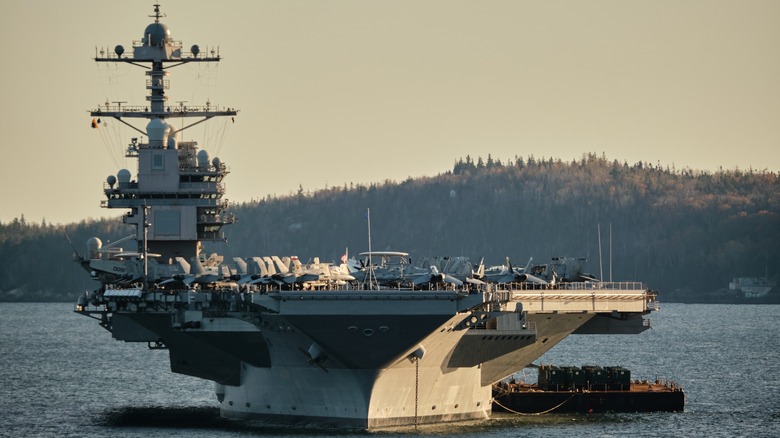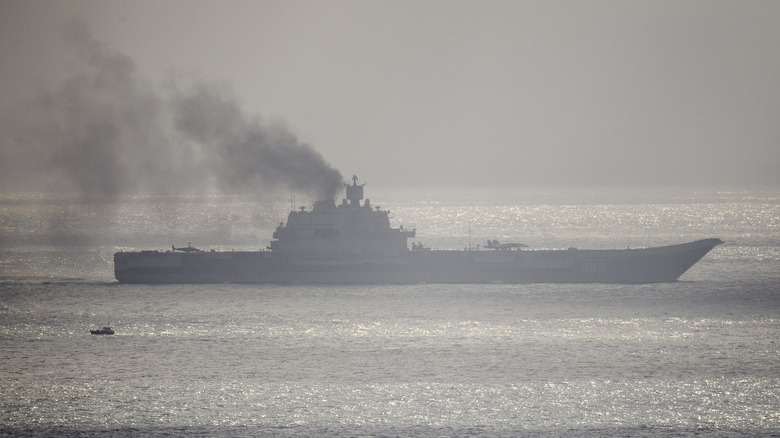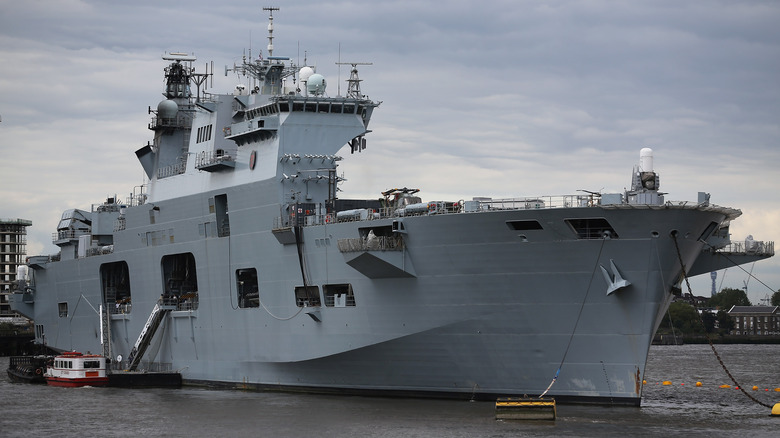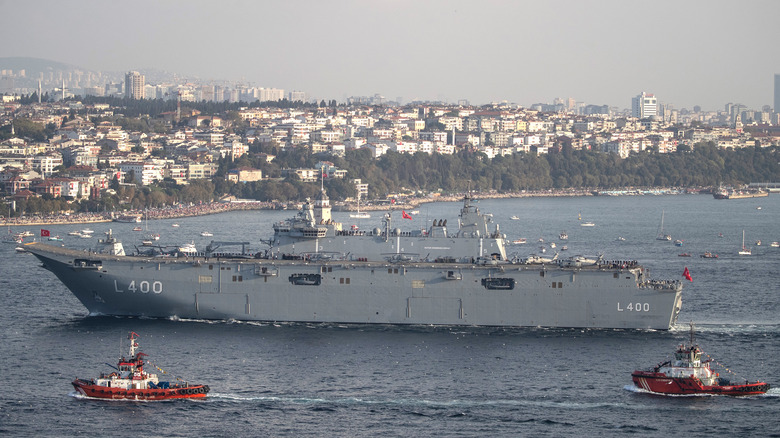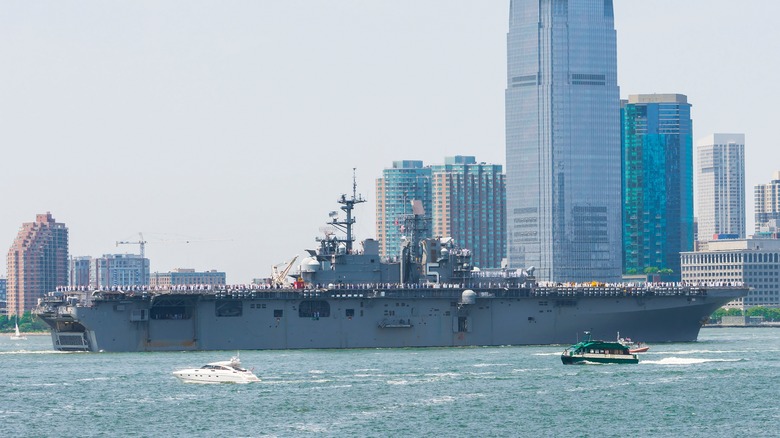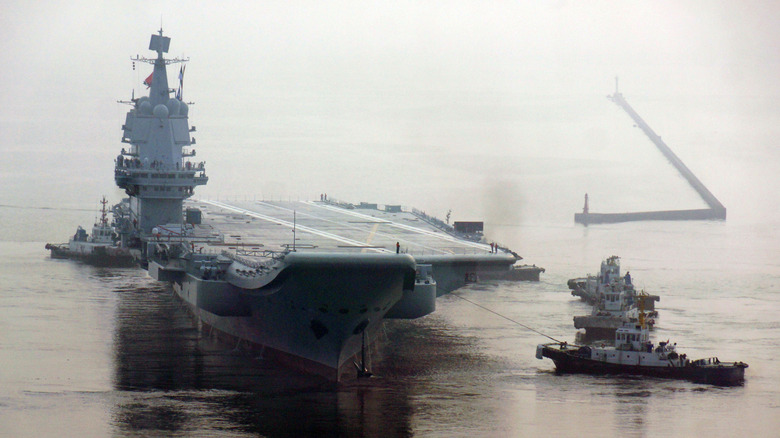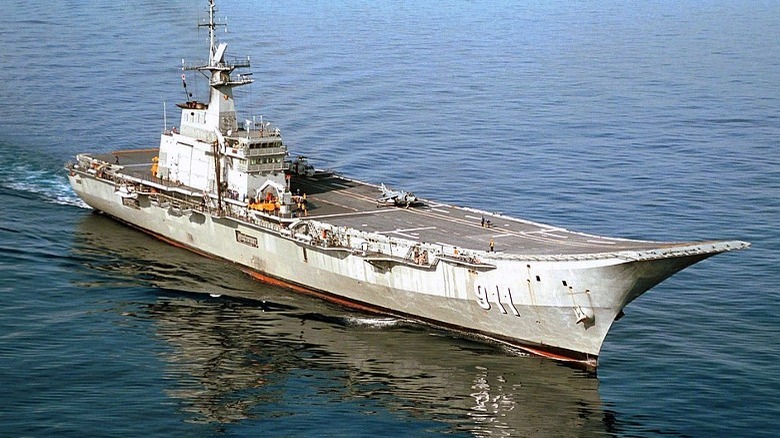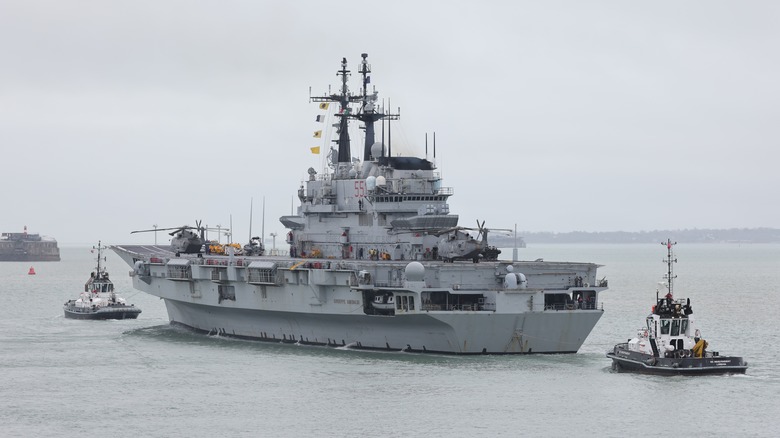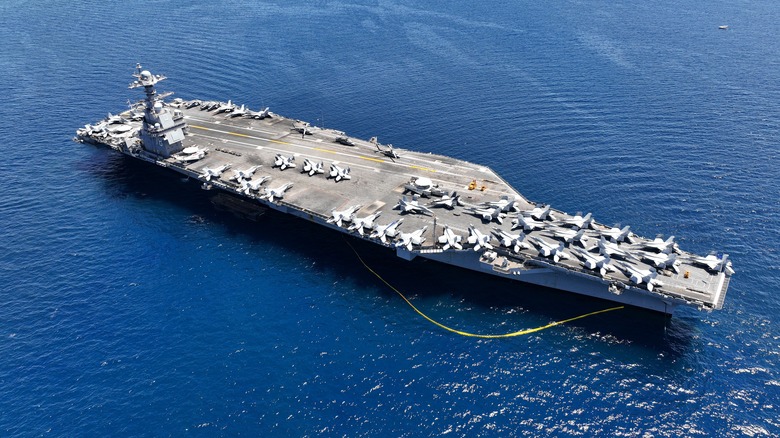What Are The Different Types Of Aircraft Carriers? (And Which Ones Does The US Navy Have?)
In modern times, the aircraft carrier is one of the most important pieces of military equipment that a nation can field. While naval vessels have always played a key role in establishing power and defending against foreign threats, the aircraft carrier gives countries the ability to extend their military reach across the planet and launch attacks quickly without the need for a land base. Often home to dozens of highly advanced fighter jets, they are a strategic powerhouse.
Of course, there isn't just one type of aircraft carrier. While today's ships are capable of carrying a large capacity of fighter jets, some of the earliest aircraft carriers were used to transport war balloons and seaplanes. Today, there are a wide array of basic variants that are used to carry out specific roles and they are often customized to do a particular job. This makes the vessels versatile and they have become an essential part of modern military operations.
Here we are going to examine the different types of aircraft carriers that are used by navies all over the world as well as revealing exactly what types of aircraft carriers the United States currently uses.
Aircraft cruiser
Typically, aircraft carriers don't have much in the way of offensive weapons. While they do come equipped with guns and armaments that can destroy incoming missiles, they rely on the complement of aircraft they carry to provide offensive capabilities. That's why aircraft carriers usually travel as part of a strike group made up of various types of different ships, including cruisers, submarines, and destroyers as they can help protect the vessel from various forms of attack.
That is not the case with aircraft cruisers, though, as these are a special type of ship that combines elements of an aircraft carrier with larger warships such as a cruiser. This gives them the ability not only to carry a large number of aircraft but also make use of offensive weapons such as missile launchers and guns. The obvious advantage of this is that the aircraft cruiser can sail alone and not be at risk.
The only nation that currently operates this type of ship is Russia, which has previously deployed Kiev-class heavy aircraft cruisers as well as the Admiral Kuznetsov. The design and classifications of the Admiral Kuznetsov allows it to travel through the Turkish Straits, with standard aircraft carriers being banned from entering the straits under the Montreux Convention. However, the U.S. has experimented with the idea of aircraft cruisers, and even considered plans for a conversion of Iowa-class battleships in the early 1980s.
Helicopter carrier
As the name of this type of vessel suggests, helicopter carriers are a subtype of aircraft carriers that are designed to carry rotary-wing aircraft — specifically, helicopters. This means that they are usually not as large as traditional aircraft carriers as the flight deck doesn't need to be as long, as helicopters can take off vertically without the need for a runway unlike fixed-wing aircraft. They are currently operated by over a dozen nations, including Australia, Brazil, and the United States.
Despite lacking the sheer firepower of aircraft carriers, helicopter carriers do have a number of advantages that make them useful in specific situations. For example, their small size means that they require a smaller crew to function and are able to fit into more confined spaces that an aircraft carrier might not be able to navigate to. In addition, almost all modern helicopter carriers are designed as amphibious assault ships that are also able to carry some fixed-wing aircraft.
One of the most famous helicopter carriers was the HMS Ocean, a British vessel that acted as the flagship of the Royal Navy and was sold to Brazil after it was decommissioned. Australia currently has the Canberra-class landing helicopter dock ships, while South Korea operates the Dokdo-class amphibious warfare helicopter carriers. Japan also has the Izumo-class helicopter carrier, although have been modified to allow them to launch STOVL aircraft.
Amphibious assault ship
Helicopter carriers are no longer as widespread as they once were. However, the basic design of the ship has evolved into what are now classed as amphibious assault ships. This distinction is important because these vessels don't just carry helicopters but can also transport STOVL aircraft like the F-35B and hold hundreds of troops, as well as a selection of impressive amphibious military vehicles. This makes them an ideal choice for amphibious landings in enemy territory.
Although they may appear similar to a helicopter carrier or other small aircraft carrier on the surface, amphibious assault ships usually have a well deck on the underside of the structure to launch landing craft and other amphibious vehicles. The primary purpose of these ships is to enable military forces to quickly establish themselves on land as part of an expeditionary strike group, with aircraft transporting supplies and troops rather than providing air support. Amphibious assault ships also play a key role in humanitarian missions. They can be operated as field hospitals and provide rapid relief to disaster zones where help is urgently needed.
The U.S. currently has both the Wasp-class amphibious assault ships and the more recent America-class landing helicopter assault ships in operation. Countries such as China, France, and Spain all have their own classes of amphibious assault ships.
Anti-submarine warfare carrier
The evolution of the submarine and its role in naval warfare means that these underwater vessels are incredibly important. Consequently, nations have put a lot of resources into developing technology and equipment to locate and destroy submarines that might pose a threat — a difficult task given that they are hidden below the sea. That led to an entire aspect of combat known as anti-submarine warfare, focusing on the ability to track down a submarine and then disable it through the use of specialist weapons.
Usually working alongside a variety of other ships that are used to hunt down submarines, the anti-submarine warfare carrier acts as a base of operations and flight deck for anti-submarine aircraft. While fixed-wing aircraft were previously used for this role, it is normal for specially customized helicopters to carry out the job today. These aircraft can do everything from deploying sensors like sonobuoys to locate and track a submarine to launching weapons such as torpedoes.
While they were more widespread during the Cold War, anti-submarine warfare carriers are still occasionally seen in the modern era. The Giuseppe Garibaldi is an Italian carrier that can be used for anti-submarine warfare, while the Japanese Hyūga-class carrier is primarily used for the same role. The U.S. Wasp-class carriers can also do the same job along with its duties as an amphibious assault ship.
Fleet carrier
Out of all the different types of aircraft carriers, the fleet carrier is the one that most people will think of when they picture this kind of ship. They essentially take up the role of leading the navy of whatever country they are commissioned in and often act as a flagship. That means that most countries have only a single fleet carrier, although major naval powers such as the United Kingdom and United States have operated a number of fleet carriers simultaneously. These have included three Invincible-class aircraft carriers used by the U.K. and an array of U.S. aircraft carriers such as the Forrestal-class.
Typically among the fastest ships in a navy, the fleet carrier will lead strike groups and be at the forefront of combat action at sea. However, they are incredibly expensive to build, often costing billions of dollars, and can take up to a decade to construct. That is why countries such as China and India initially purchased incomplete or decommissioned aircraft carriers to put into service rather than build brand new aircraft carriers entirely from scratch. The Chinese ship Liaoning was originally built in Ukraine, while the Shandong was based on the design of the Kuznetsov-class for example.
Light aircraft carrier
A light aircraft carrier is nothing other than an aircraft carrier that can be classed as smaller than the vast majority of standard aircraft carriers that a navy might operate. Although a lot of countries operate aircraft carriers, only a few have fleet carriers or supercarriers that most people associate with this type of ship. Even those that do have the larger variants may supplement them with smaller and cheaper vessels.
These types of vessels have a number of advantages despite the fact that they can't project the same kind of air power as their larger cousins. They are far cheaper to build, costing a fraction of the price of larger aircraft carriers. The ships are also less expensive to maintain, require a smaller crew to operate, and can be constructed over a shorter time frame. Of course, light aircraft carriers are limited in terms of the number of aircraft they can carry, as well as being restricted in terms of the type of aircraft due to a shorter flight deck.
Only a small selection of light aircraft carriers are still in use today. Italy operates both the Giuseppe Garibaldi and the Cavour, while the Spanish navy has the Juan Carlos I. Meanwhile, Thailand has a single aircraft carrier in its navy in the form of the HTMS Chakri Naruebet, thought to be the smallest aircraft carrier in the world.
[Featured image by United States Navy via Wikimedia Commons | Cropped and scaled | Public Domain]
Helicopter cruisers
Much like aircraft cruisers, helicopter cruisers are a hybrid design that sits somewhere between an aircraft carrier and a warship. They were developed during the 1960s at a time when aircraft carriers were not as large or imposing as they are today but nations still wanted to be able to project air power quickly and efficiently. One of the earliest example of this type of ship came from France, with the Jeanne D'Arc, which entered service in 1964 and featured a flight deck and hangar along with the offensive capabilities of a typical warship of the time.
The Jeanne D'Arc straddled several roles, allowing the French Navy to work as both an anti-submarine carrier and a cruiser that was fast and powerful enough to hold its own. The idea of the helicopter cruiser was taken up by Italy in the late 1960s, with the nation launching the Vittorio Veneto. Later, Italy also put the Giuseppe Garibaldi into service before the Cavour was commissioned in 2004.
The only other major helicopter cruisers came from the Soviet Union. The country's navy produced both the Moskva and the Leningrad, both of which resembled the Jeanne D'Arc in terms of its shape and design. That meant that the front half of the ship looked like a cruiser, while the back half was essentially just a flight deck.
Supercarrier
There is no strict definition of a supercarrier, meaning that organizations and military forces across the globe may designate ships differently. The common thinking is that supercarriers are a select group of aircraft carriers that comprises the largest and most powerful. Typically, this only includes the aircraft carriers manufactured and operated by the United States. However, some do consider the United Kingdom's Queen Elizabeth-class carriers to fit the description.
The defining feature of supercarriers is that they are massive. The biggest aircraft carriers in the world are all supercarriers that are in service within the U.S. Navy. They range in size from the earlier Nimitz-class ships that can displace around 97,000 tons when fully loaded to the Gerald R. Ford-class aircraft carrier, which displaces a staggering 100,000 tons. Both of these ships are nuclear powered, as were the older U.S. supercarriers such as the Enterprise-class and the Kitty Hawk-class, giving them a seemingly unlimited range.
Currently there is a single Gerald R. Ford-class aircraft carrier in service. The USS Gerald R. Ford is capable of carrying up to 75 aircraft, ranging from fixed-wing F-35s to a variety of helicopters and F/A-18E Super Hornets. Standing at over 1,100 feet, it is made up of 25 decks and stands at a mighty 250 feet tall.
